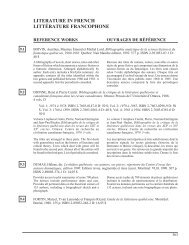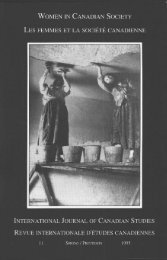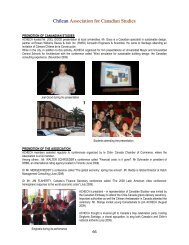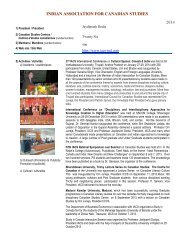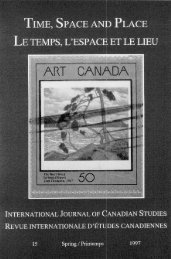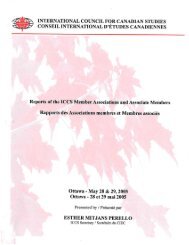Arts and Literature in Canada:Views from Abroad, Les arts et la ...
Arts and Literature in Canada:Views from Abroad, Les arts et la ...
Arts and Literature in Canada:Views from Abroad, Les arts et la ...
- No tags were found...
You also want an ePaper? Increase the reach of your titles
YUMPU automatically turns print PDFs into web optimized ePapers that Google loves.
The Architecture of Arthur Erickson: Redeem<strong>in</strong>g Modernity2. Few cultural critics have resisted cit<strong>in</strong>g the <strong>in</strong>fluence of architectural theorists <strong>and</strong>architecture as progenitors of postmodern sensibilities; recurrent references to RobertVenturi <strong>and</strong> Charles Jencks, the Piazza d'Italia <strong>and</strong> the Portl<strong>and</strong> Municipal Services Build<strong>in</strong>gappear <strong>in</strong> the cultural studies literature (see especially, Jameson, 1991; Harvey, 1989; Gitl<strong>in</strong>,1989; Jameson, 1983; <strong>and</strong> Habermas, 1981). The media hype that accompanied the rise ofpostmodernism was also considerable. It is worth recall<strong>in</strong>g, especially with regard to thepopu<strong>la</strong>rization of postmodernism through its architectural imagery, that Phillip Johnson'sAT&T Tower graced the cover of New York Magaz<strong>in</strong>e <strong>in</strong> 1978 <strong>and</strong> that the shelter magaz<strong>in</strong>e,M<strong>et</strong>ropolitan Home, was virtually born of the earliest impulses of postmodern design.3. The discr<strong>et</strong>e construction of the modernism/postmodernism dialectic affords a reasonableframework for juxtapos<strong>in</strong>g problems of formal expression <strong>and</strong> period specific architecturalideology that are raised directly by the nature of Arthur Erickson's work. Themodernism/postmodernism dialectic is but one of several conceptual juxtapositions thatform key conceptual po<strong>in</strong>ts of departure for consider<strong>in</strong>g postmodernism as a culturalconstruct. A parallel breakdown of clearly-cut dist<strong>in</strong>ctions b<strong>et</strong>ween high culture <strong>and</strong> mass,or popu<strong>la</strong>r culture, is also prom<strong>in</strong>ent <strong>in</strong> the postmodern discourse, (see especially Huyssen,1986). The socio-economic construction of postmodernism focuses on the emergence ofnew features of culture <strong>in</strong> a contemporary soci<strong>et</strong>y dom<strong>in</strong>ated by multi-national corporatecapitalism, <strong>and</strong> mass-mediated, consumer-oriented communication systems, (see especiallyJameson, 1983; Harvey, 1989; <strong>and</strong> Habermas, 1975). While this broader contextualframework <strong>in</strong>forms the consideration of Erickson's work, it also m<strong>and</strong>ates an <strong>in</strong>-depthdiscussion of the cultural problematics of <strong>Canada</strong> positioned <strong>in</strong> a <strong>la</strong>rger North Americansituation that deeply affects its socio-economic <strong>and</strong> political situation which is beyond thescope of this essay.4. For an <strong>in</strong>formative review of the history of modernity which explores <strong>and</strong> contextualizes theimplications of postmodernism's reactionary, anti-modernist stance see Habermas, 1981.5. See especially Jameson, 1991, chapter 2, “Theories of the Postmodern.” Like manypostmodern critics <strong>in</strong> the cultural studies arena, Jameson is <strong>in</strong>sufficiently <strong>in</strong>formedconcern<strong>in</strong>g the doma<strong>in</strong> of architectural history which his work appropriates; evidence of thisis his cont<strong>in</strong>ual conf<strong>la</strong>tion of the contributions of Mies van der Rohe, Le Corbusier <strong>and</strong> FrankLloyd Wright <strong>in</strong>to a s<strong>in</strong>gu<strong>la</strong>r doctr<strong>in</strong>e of modern architecture.6. It can be argued that the historiography <strong>and</strong> monuments of modern architecture, particu<strong>la</strong>rly<strong>in</strong> North America, demonstrate considerable awareness of regional specificity. Indeed,regionalism, which connotes neither “modernism” nor “postmodernism” per se, necessarily<strong>in</strong>corporates the h<strong>et</strong>erogeneity of conflict<strong>in</strong>g styles; the “modern” works of Wright, LouisKahn <strong>and</strong> Richard Neutra, to cite a few key examples, tog<strong>et</strong>her with those of Erickson,provide cases <strong>in</strong> po<strong>in</strong>t. However, universal pr<strong>in</strong>ciples underlie regional concerns <strong>in</strong> thearchitecture of such modernists; regional d<strong>et</strong>erm<strong>in</strong>ants of culture <strong>and</strong> site can act <strong>in</strong> consortwith the non-<strong>in</strong>digenous factors of tectonics, space <strong>and</strong> expression.7. I refer here to Charles Jencks's dec<strong>la</strong>ration of the death of Modern Architecture on July 15,1972 with the demolition of the Pruitt-Igoe Hous<strong>in</strong>g Project (M<strong>in</strong>oru Yamasaki, St. Louis,Missouri, 1952-55). Hailed as an exemp<strong>la</strong>r of modernism as dictated <strong>in</strong> Le Corbusier'spr<strong>in</strong>ciples for mass hous<strong>in</strong>g, the project won a prestigious design award <strong>from</strong> the AmericanInstitute of Architects at the time of its design <strong>in</strong> 1951. Barely 20 years <strong>la</strong>ter, the 14-story s<strong>la</strong>blik<strong>et</strong>owers were v<strong>and</strong>alized to such a degree that, <strong>in</strong> spite of concerted, <strong>and</strong> expensiverehabilitation efforts, the muti<strong>la</strong>ted projects were deemed unsalvageable. The build<strong>in</strong>g's“universal” modern style proved to be at odds with the architectural codes <strong>and</strong> expectations ofits low-<strong>in</strong>come <strong>in</strong>habitants (see Jencks, 1977, p. 9).8. Although Erickson's dismissal of the stage-s<strong>et</strong> qualities of such works was broadly cast,much of his wrath was directed toward Michael Graves's w<strong>in</strong>n<strong>in</strong>g scheme for the widelypublicized 1979 Portl<strong>and</strong> Municipal Services Build<strong>in</strong>g comp<strong>et</strong>ition. Erickson's entry to thiscomp<strong>et</strong>ition was not successful, <strong>and</strong> he decried Graves's failure to comprehend fully thecontext <strong>and</strong> sense of p<strong>la</strong>ce of the Pacific Northwest. Graves's scheme, compl<strong>et</strong>ed <strong>in</strong> 1982, is ablock-like tower, ris<strong>in</strong>g <strong>from</strong> a colonnade that hugs the stre<strong>et</strong>; decorated with swags,garl<strong>and</strong>s, <strong>and</strong> pi<strong>la</strong>sters abstracted <strong>from</strong> a C<strong>la</strong>ssical vocabu<strong>la</strong>ry of design, it is pa<strong>in</strong>ted <strong>in</strong> thepastel shades often associated with postmodern architecture of the early 1980s. In contrast,the Erickson scheme, which featured an arcade, considerably recessed <strong>from</strong> the stre<strong>et</strong>,41



